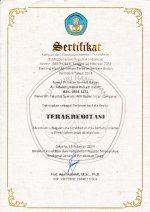Time Value of Money dalam Perspektif Hukum Islam
Abstract
Keywords
Full Text:
PDF (Bahasa Indonesia)References
Antonio, Muhammad Syafi’i. Bank Syariah dari Teori ke Praktik. Jakarta: Gema Insani Press, 2001.
Ahmad, Abu Umar Faruq, and M. Kabir Hassan. “The Time Value of Money Concept in Islamic Finance.” American Journal of Islamic Social Sciences 23, no. 1 (2006): 66.
Arifin, Zainul. Dasar-dasar Manajemen Bank Syariah. Jakarta: Alvabeta, 2006.
Achsien, Iggi H. Investasi Syariah di Pasar Modal: Menggagas Konsep dan Praktek Manajemen Portofolio Syariah. Surakarta: Gramedia Pustaka Utama, 2009.
Capra, M. Umar. Masa Depan Ilmu Ekonomi: Sebuah Tinjauan Islam. Jakarta: Gema Insani Press, 2001.
Chandra, M. Jeya, and Michael L. Bahner. “The Effects of Inflation and the Time Value of Money on Some Inventory Systems.” International Chang, Horng-Jinh, Cheng-Hsing Hung, and Chung Yuan Dye. “A Finite Time Horizon Inventory Model with Deterioration and Time-Value of Money Under the Conditions of Permissible Delay in Payments.” International Journal of Systems Science33, no. 2 (2002): 141-151.
Diwanti, Rela. “Pemikiran Ibnu Rusyd Tentang Qiradh dan Implikasinya dengan Produk Qiradh Pada Bank Riau Syariah Cabang Pekanbaru.” PhD diss., Universitas Islam Negeri Sultan Syarif Kasim Riau, 2010.
Datta, T. K., and A. K. Pal. “Effects of Inflation and Time-Value of Money on an Inventory Model with Linear Time-Dependent Demand Rate and Shortages.” European Journal of Operational Research 52, no. 3 (1991): 326-333.
Dey, Jayanta Kumar, Shyamal Kumar Mondal, and Manoranjan Maiti. “Two Storage Inventory Problem with Dynamic Demand and Interval Valued Lead-Time Over Finite Time Horizon Under Inflation and Time-Value of Money.” European Journal of Operational Research 185, no. 1 (2008): 170-194.
Departemen Agama. Alquran dan Terjemahnya. Semarang: Asy Syifa, 2000.
Hasan, Ahmad. Mata UangIslami: Telaah Komprehensif Sistem Keuangan Islami. Trans. oleh Saifurrahman Barito Jakarta: PT Raja Grafindo Persada, 2005.
Hou, K-L., and L-C. Lin. “An EOQ Model for Deteriorating Items with Price-and Stock-Dependent Selling Rates Under Inflation and Time Value of Money.” International Journal of Systems Science 37, no. 15 (2006): 1131-1139.
Karim, Adiwarman A. Ekonomi Makro Islami. Jakarta: PT Raja Grafindo Persada, 2007.
_____, Bank Islam: Analisis Fiqh dan Keuangan. Jakarta: PT Raja Grafindo Persada, 2006.
Khan, M. Fahim. “Time Value of Money and Discounting in Islamic Perspective.” Review of Islamic Economics 1, no. 2 (1991): 35-45.
Lubis, Dian Asriani. “Kepailitan Menurut Ibnu Rusyd dan Perbandingannya dengan Hukum Kepailitan Indonesia.” PhD diss., Universitas Islam Negeri Sultan Syarif Kasim Riau, 2011.
Mondal, Madhab, Amit Kumar Maity, Manas Kumar Maiti, and Manoranjan Maiti. “A Production-Repairing Inventory Model with Fuzzy Rough Coefficients Under Inflation and Time Value of Money.” Applied Mathematical Modelling 37, no. 5 (2013): 3200-3215.
Muhammad. Manajemen Bank Syariah. Yogyakarta: UPP AMP YKPN, 2005.
_____, Dasar-dasar Keuangan Islam. Yogyakarta: Ekonosia, 2011.
Manullang, Manginar. Pengantar Teori Ekonomi Moneter. Deli: Deli Pertjetakan & Toko Buku, 1962.
Mansoori, Muhammad Tahir dan Hendri Tanjung. Kaidah-kaidah Fiqih Keuangan dan Transaksi Bisnis. Trans. oleh Aini Aryani. Bogor: Ulil Albaab Institute, 2010.
Nabhani, Taqyuddin al-. Membangun Sistem Ekonomi Alternatif Persepektif Islam, Cet.VIII. Surabaya: Risalah Gusti, 2009.
Qasim, Abû ‘Ubaid al-. Ensiklopedia Keuangan Publik. Trans. oleh Setiawan Budi Utomo. Jakarta: Gema Insani Press, 2009.
Rozalinda. Ekonomi Islam: Teori dan Aplikasinya pada Aktivitas Ekonomi. Jakarta: PT Raja Grafindo Persada, 2014.
Rahman, Afzalur. Doktrin Ekonomi Islam, 2. Yogyakarta: PT. Dana Bhakti Wakaf, 1995.
Rivai, Veithzal dan Andi Buchari. Islamic Economics. Jakarta: PT Bumi Aksara, 2009.
Sarker, Bhaba R., and Haixu Pan. “Effects of Inflationand the Time Value of Money on Order Quantity and Allowable Shortage.” International Journal of Production Economics 34, no. 1 (1994): 65-72.
Sarkar, Biswajit, Shib Sankar Sana, and Kripasindhu Chaudhuri. “An Imperfect Production Process for Time Varying Demand with Inflation and Time Value of Money–an EMQ Model.” Expert Systems with Applications 38, no. 11 (2011): 13543-13548.
Shawi, Abdullah al-Muslih dan Shalah Ash-. Fikih Ekonomi Keuangan Islam. Trans. oleh Abu Umar Basyir. Jakarta: Darul Haq, 2004.
Shah, Nita H. “Inventory Model for Deteriorating Items and Time Value of Money for a Finite Time Horizon Under the Permissible Delay in Payments.” International Journal of Systems Science 37, no. 1 (2006): 9-15.
Sholihin, Ahmad Ifham. Buku Pintar Ekonomi Syariah. Jakarta: PT. Gramedia Pustaka Utama, 2010.
Shihab, M. Quraish. Tafsir al-Misbah. 15, Cet. 5. Jakarta: Lentera Hati, 2012.
Singh, S. R., Neeraj Kumar, and Rachna Kumari. “Two-Warehouse Inventory Model for Deteriorating Items with Shortages Under Inflation and Time-Value of Money.” International Journal of Computational and Applied Mathematics 4, no. 1 (2009): 83-94.
Wee, Hui-Ming, and Sh-Tyan Law. “Replenishment and Pricing Policy for Deteriorating Items Taking Into Account the Time-Value of Money.” International Journal of Production Economics 71, no. 1-3 (2001): 213-220.
_____, “Economic Production Lot Size for Deteriorating Items Taking Account of the Time-Value of Money.” Computers & Operations Research 26, no. 6 (1999): 545-558.
DOI: http://dx.doi.org/10.24042/adalah.v14i1.1991
Refbacks
- There are currently no refbacks.
Copyright (c) 2017 AL-'ADALAH
Al-'Adalah is licensed under a Creative Commons Attribution-ShareAlike 4.0 International License.



.png)
_(1).png)
_(1).png)

.png)
